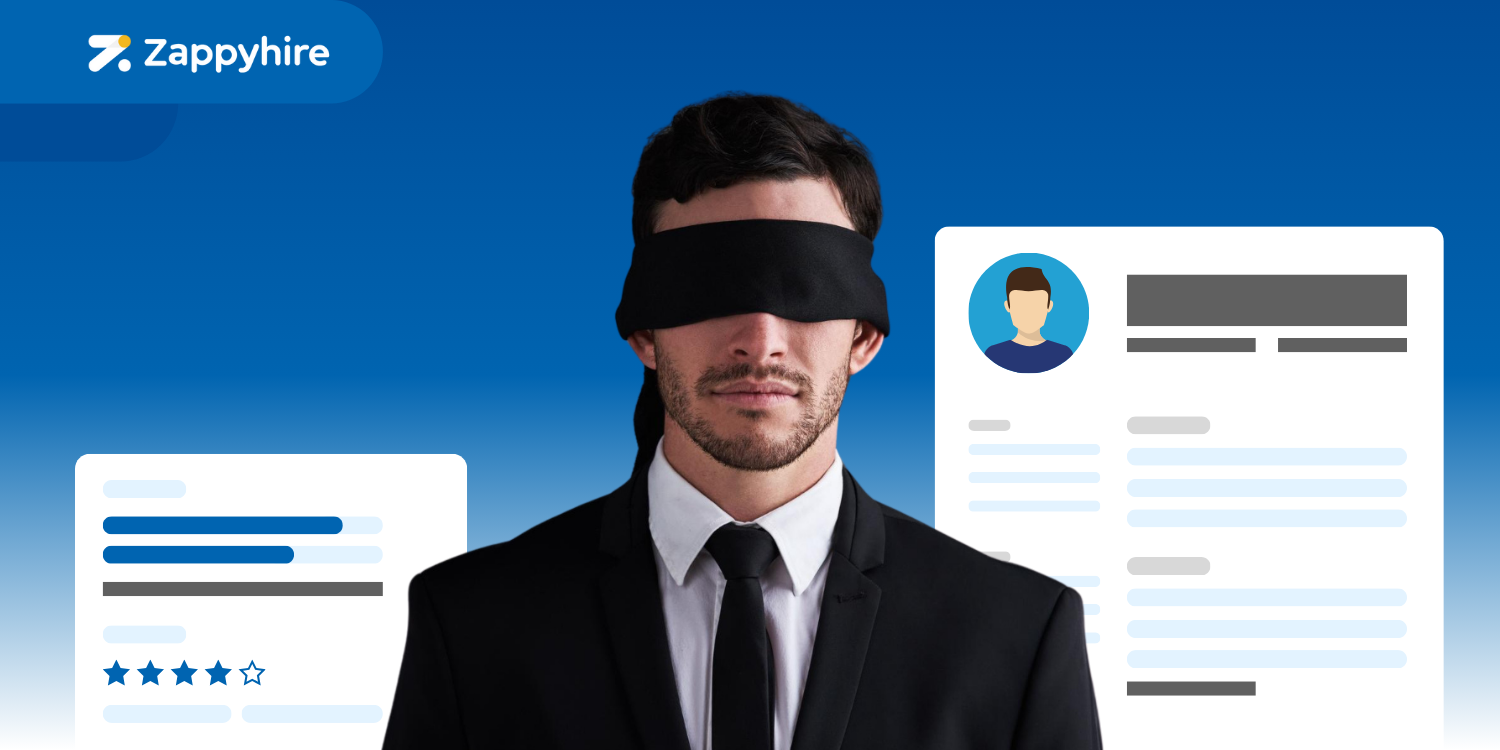
Let’s face it – we all have biases.
Whether it’s favoring someone who shares our background or feeling an instant connection with a candidate who mirrors our own experiences, these biases are hardwired into our thinking.
These biases can be particularly tricky when they take the form of specific types of hiring bias that many recruiters might not even realize they’re engaging in.
For instance, studies show that applicants with foreign-sounding names need to send 50% more applications than equally qualified applicants from the majority group to be invited to a job interview.
It’s time to get real about the types of biases in recruitment that creep into the process – because hiring the best talent starts with knowing where our blind spots are.
What is hiring bias?
Hiring bias is a preference or prejudice that affects our judgment during the recruitment process.
It’s that little voice in your head that whispers, “This one feels right,” even if you can’t pinpoint why.
These biases can be conscious – like favoring a candidate because they attended the same college as you – or unconscious, where decisions are made without you even realizing why.
The trickiest part? Unconscious biases are often the most influential because they operate below the surface, quietly shaping our thoughts and actions.
They’re the silent puppeteers pulling the strings without us even noticing.
Conscious vs. Unconscious Bias
Conscious bias is pretty straightforward – it’s when you’re aware of your preferences. Maybe you always lean toward candidates from certain universities or those who’ve worked at specific companies.
You know you’re doing it, even if you justify it with, “They’ll fit in better.”
But unconscious bias is a silent puppet master. It’s that gut feeling you can’t quite explain.
These biases are built into us through years of experience, culture, and personal history, making them much harder to spot and control.
They’re like the hidden filter through which we see the world – subtle, pervasive, and often unacknowledged.
10 types of hiring biases to watch out for
Biases in hiring come in all shapes and sizes. Let’s break down ten of the most common biases in recruitment so you can start recognizing them in your own decisions.
1. Halo/Horns Effect
This bias occurs when one trait – be it good or bad – overshadows everything else about a candidate.
If someone dazzles you in one area (Halo), you might find yourself overlooking their flaws. Conversely, if they falter in one aspect (Horns), you might dismiss their strengths without a second thought.
Let’s take a candidate who nails the interview with charisma. They’re engaging, charming, and leave a lasting impression.
But what about their lack of relevant experience? Suddenly, it doesn’t seem so important – until it’s too late.
How to mitigate this
- Use structured interviews with standardized questions to keep the process fair.
- Review candidates based on objective criteria, not just first impressions.
- Adopt tools like ZappyVue to ensure consistency in evaluations, so you’re not swayed by one standout moment.
| 💡 Recommended Article How to Conduct a Structured Interview |
2. Ageism
Ageism creeps in when we make assumptions based on someone’s age.
We might think older candidates are out of touch with modern trends or that younger ones lack maturity.
It’s a bias that’s both unfair and often inaccurate.
For example – missing a candidate in their 50s because you assume they’re not tech-savvy. Or bypassing a recent grad because you think they’re too green for the job.
Both are missed opportunities.
How to mitigate this
- Take extra care to focus on skills and experience rather than age.
- Use AI-powered screening tools to reduce age-related assumptions, ensuring every candidate gets a fair shake.
3. Gender Bias
Gender bias is the tendency to favor one gender over another, often based on deep-seated stereotypes.
It’s the kind of bias that’s easy to overlook but hard to ignore when you’re on the receiving end.

Let’s say there are two candidates with identical qualifications – one male, one female.
Yet somehow, the male candidate is rated as more competent and offered a higher salary. It happens more often than we’d like to admit, especially in fields like STEM.
Studies show that gender bias leads to lower callback rates for women, even when their qualifications match or exceed those of male candidates.
This is particularly true in male-dominated industries, where stereotypes about leadership and assertiveness often result in men being preferred for top roles.
How to mitigate this
- Blind resumes to remove gender-identifying information.
- Promote diversity by ensuring balanced and collaborative hiring panels.
4. Cultural Bias
Cultural bias occurs when we favor candidates who share our cultural background, often without even realizing it.
For example, you might feel more comfortable with someone who shares your language, customs, or even your sense of humor. But does that really make them the best fit for the job? Probably not.
This can lead to a lack of workplace diversity in thought and experience, ultimately stifling innovation.
How to mitigate this
- Implement diversity training for hiring teams to raise awareness.
- Use software that anonymizes cultural indicators during initial screenings, so candidates are judged on their qualifications, not their background.
5. Recency Bias
Recency bias is the tendency to give undue weight to the most recent information when evaluating a candidate, rather than considering their full history.
For instance, if a candidate stumbles on a final interview question, it might overshadow all their previous stellar answers.
Or if their latest job was a short-term gig, you might overlook a long history of success.
It’s like being distracted by the last thing you saw, even if it’s not the most important.
How to mitigate this
- Review all candidate materials comprehensively, not just the last thing they said or did.
- Use tools like Zappyhire to track and compare candidate data over time, so you get the full picture, not just the latest snapshot.
6. Nonverbal Bias
Nonverbal bias is when we judge candidates based on body language, tone of voice, or other nonverbal cues rather than their actual qualifications.
It’s like being swayed by the packaging and missing out on what’s inside (judging the book by its cover, basically).
For example, a candidate who’s soft-spoken might be seen as lacking confidence, while someone with a firm handshake might be deemed more capable – even if neither assumption is true.
This bias can be particularly detrimental to neurodivergent candidates.
Note – Neurodivergent candidates are individuals whose brains function differently from the neurotypical population.
This can include people with autism, ADHD, dyslexia, and other neurological differences.
These candidates often bring unique perspectives and strengths to the workplace, but may communicate or behave in ways that diverge from typical expectations, making them more vulnerable to nonverbal bias.

A recent study in the UK revealed that 48% of neurodivergent employees felt that recruitment processes were unfair to them.
Many neurodivergent individuals might not make direct eye contact or could display body language that differs from what’s typically expected, but this doesn’t reflect their competence or potential.
In fact, 63% of neurodivergent employees reported feeling the need to mask their true selves at work, which can lead to stress and a lack of authenticity in the workplace.
Think of it this way – someone who avoids eye contact or doesn’t smile as much could be seen as unengaged, when in reality, they might just have a different way of interacting with the world.
How to mitigate this
- Be aware of your own reactions to nonverbal cues and question whether they’re relevant to the job.
- Focus on the content of what the candidate says rather than how they say it. Sometimes, the quietest voices have the most important things to say.
7. Stereotyping
Stereotyping is when we apply generalized beliefs about a group to an individual. It’s a shortcut our brains take, but it can lead to unfair assumptions and missed opportunities.
Like assuming that a woman might not be interested in a leadership role because she has young children, or that a man wouldn’t be a good fit for a nurturing position like nursing.
These stereotypes are not just wrong – they’re harmful.

How to mitigate this
- Challenge your assumptions by asking follow-up questions that get to the truth.
- Ensure your evaluation criteria are based on job relevance, not stereotypes. And use collaborative hiring tools so that the biases’ impact is reduced.
8. Affinity Bias
Affinity bias is when we favor someone because they’re similar to us in some way – maybe they share our hobbies, background, or even our taste in music. It’s comforting, but it can also be limiting.
You might be more inclined to hire someone who’s into the same sports team as you or who grew up in the same town. But are they really the best person for the job, or just the most familiar?
How to mitigate this
- Diversify your interview panel to get multiple perspectives. What’s familiar to you might be totally different to someone else.
- Use AI-powered assessments and structured scoring systems to minimize personal bias, focusing on skills and experience rather than shared interests.
9. Confirmation Bias
Confirmation bias is the tendency to seek out information that confirms your pre-existing beliefs about a candidate, while ignoring all evidence to the contrary. It’s like putting on blinders and only seeing what you want to see.
If you believe a candidate is perfect for the job, you might focus on their strengths and brush off any red flags. Or if you’ve already decided they’re not a good fit, you might disregard their qualifications entirely.
How to mitigate this
- Encourage a devil’s advocate approach during hiring discussions, where someone challenges the prevailing opinion.
- Rely on data-driven insights, possibly from tools like Zappyhire, to guide decisions. It’s harder to argue with the numbers than with your gut.
10. Beauty Bias
Beauty bias is the tendency to favor candidates based on physical appearance, often assuming that attractive individuals are more competent or capable.
It’s as shallow as it sounds, but it’s surprisingly common.

There’s a chance you might find yourself leaning toward a candidate who’s well-dressed and conventionally attractive, even if their resume doesn’t stack up.
Or you might dismiss someone because they don’t fit your idea of what a professional looks like.
How to mitigate this
- Conduct blind initial interviews, such as phone or AI-driven assessments, where appearance isn’t a factor.
- Keep evaluation criteria strictly related to job performance, not to how someone looks. After all, it’s the inside that counts.
| 💡 Recommended Article How One-Way Video Interviews Prevent Bias in Hiring |
We all have biases – it’s how we manage them that makes the difference
Admitting we have biases doesn’t make us bad people – it makes us human.
If we’re serious about hiring the best and brightest, we need to get real about the types of bias in recruitment that sneak into our decisions.
Because, let’s be honest, the first step in solving any problem is admitting we have one.
It’s not about eliminating bias altogether (which, let’s be real, is impossible). It’s about making conscious efforts to choose the best candidate based on merit, not on our unconscious preferences.
And if you’re looking for a smart, efficient, and bias-free hiring solution, ZappyVue is here to help you find the right talent – fair and square!






